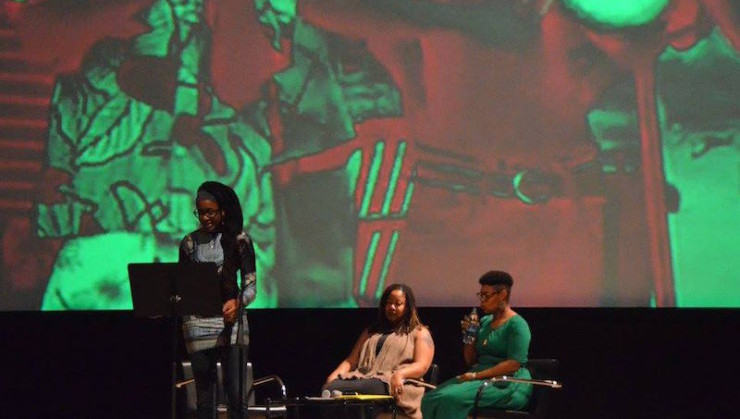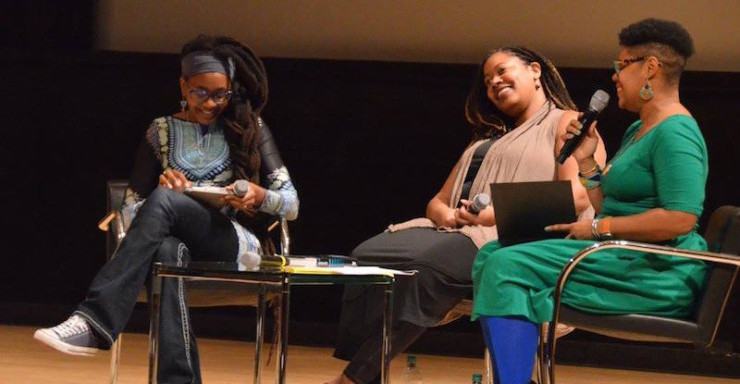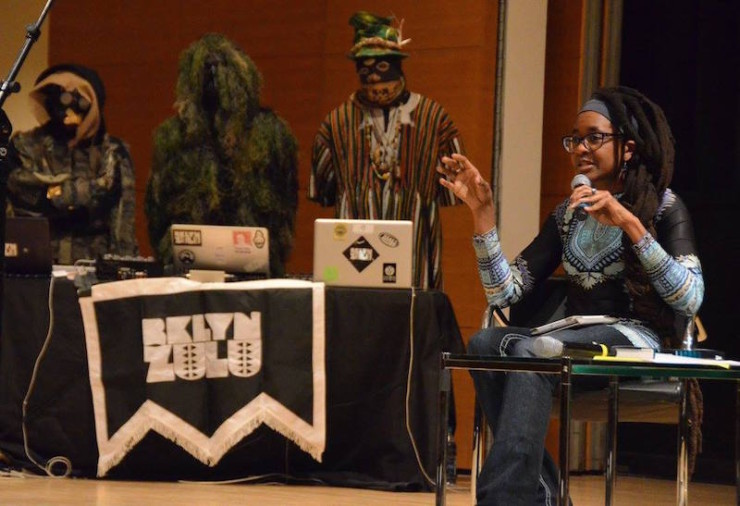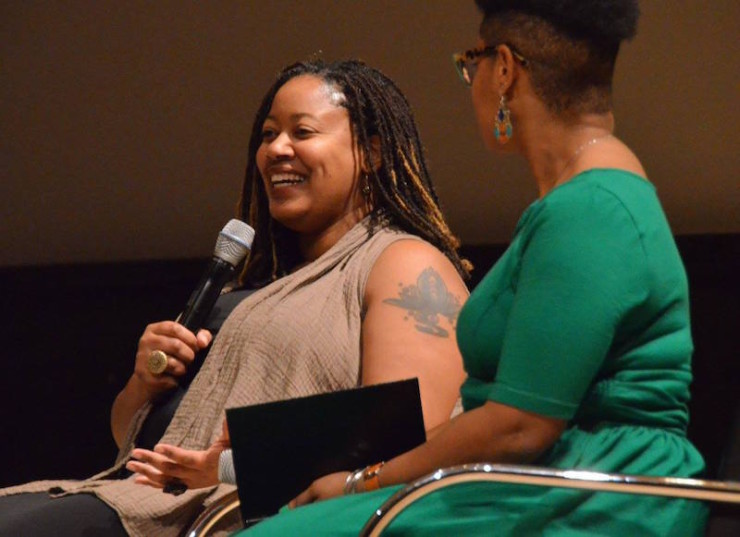Every month, the Brooklyn Museum presents Target First Saturdays, in which current and prospective patrons can explore the museum free of charge and take in the current exhibits as well as multimedia programming linked by theme. Patrons attending this month’s event had the opportunity to learn about the Yoruba tradition of masquerade, take in a screening of the documentary Paris Is Burning, and attend a book club in which N.K. Jemisin, Nnedi Okorafor, and Ibi Zoboi read from their novels while the performing arts collective BKLYN ZULU presented audio and visual soundscapes inspired by their work.
As the exhibit Disguise: Masks and Global African Art explains, masquerade can be a form of disguise, a tool for exchanging power, a way to hide and a way to be seen. Taking in the exhibit before the book club was incredibly rewarding, as the aforementioned themes became a backdrop against which to consider Okorafor and Jemisin’s selections—a chapter from Lagoon and “The Effluent Engine,” respectively. BKLYN ZULU’s work combined visuals of masquerade, the Internet, and the streets of Detroit (where Zoboi’s forthcoming novel, American Street, is set). There were a number of unintentional connections, as well: Lagoon and American Street both conjured up Legba, the Yoruba trickster god of language, communication, and the crossroads. And, in one of the night’s best moments, Okorafor said that one of the BKLYN ZULU members was dressed just like one of the masquerades who used to chase her around the streets of Nigeria with a whip as part of teasing children when the “Americanized Igbos” would visit. (When the panelists offered that she could move, Okorafor joked, “I know exactly where he is!”)
The authors (who are all friends) discussed writing from behind or in front of a mask, how they were initiated into their identities as writers, and the usefulness (or not) of Afrofuturism as a label. Read on for the highlights!
Creating in Plain Sight or Masked in Metaphor?
To open the discussion, Zoboi read the first few lines from Paul Laurence Dunbar’s poem “We Wear the Mask”:
We wear the mask that grins and lies,
It hides our cheeks and shades our eyes,—
This debt we pay to human guile;
With torn and bleeding hearts we smile,
And mouth with myriad subtleties.
Zoboi then asked Jemisin and Okorafor if their writing within SFF—”a genre that we all know has historically excluded marginalized voices”—is creating, protesting, and innovating in plain sight, or masked with the aforementioned myriad subtleties?
Jemisin explained that she does both: “Some of what I do is overtly reimagining the world as it is. As we all know, Haiti has been the target of several centuries of sustained attack by the Western world because it represents in a lot of ways the things that the Western world was built upon, and that they were terrified of getting loose. So, of course, writing a story in which the people of Haiti are becoming a superpower through the use of steam technology and rum was something I did for fun, as a mental game. I also do a lot of writing in secondary worlds, worlds that are not Earth. In these worlds, I’m playing with race and class and culture because these cannot be classes and cultures of our world. I can’t say that the people I’m writing about are African-American because there’s no Africa, there’s no America, but they’re black. I can write allegories for racial oppression; in The Fifth Season, the people who are oppressed are people who have the magical ability to start earthquakes, which is not racial. [But] the experiences that they go through, the suffering that they undergo, the techniques and methods used by the oppressors to keep them in place, were all taken from real-world events. […] Even though these are not our people, you can see the bones of people who have really died.”
“I create in plain sight,” Okorafor said, citing her reasoning for starting to write African-based, magical realism stories (“they’re my realism”): “I started writing these stories because I wasn’t seeing them, I wasn’t seeing reflections of myself. I’ve always been a blunt person. I knew that even when I started writing these stories, I didn’t want to shorten my name, I would not write under a pen name; I wanted my whole name to be on there even if it scared readers away because it’s so complicated. The same goes for the characters, too. I never wanted to hide the race of my characters. If I’m writing a black, African character who is dark-skinned with black hair, I will say that. I’m not going to leave it up to my readers to figure it out because we all know about something called the default. If you don’t specify, you know what especially Western readers are going to fill in.”
Masquerades as Initiation
The most interesting discussion of the night reflected the themes of masquerade presented in other exhibits at the museum. Zoboi invited Okorafor and Jemisin to envision themselves as masked initiatives, “whose creative process is both sacred and transformative”—ritual drama that is transportive and presents their words and stories in a different light. Zoboi then asked them to each explain their initiation process, and shared her own as an example: “I’m being initiated into the bowels of […] the written word, the history of publishing as being exclusionary to certain voices. I find myself in meetings where I’m the only person of color there, and I have to go through a personal transformation in order to be able to sit there and feel that I belong there, that my voice belongs there.”
“Why is that not an initiation of the publishing industry into finally speaking the voices and telling the tales of the whole society that’s supposed to be represented?” Jemisin countered. “That’s not your initiation to society. […] That is that industry finally maturing into the industry it was always supposed to be.”
Okorafor’s initiation was her experience with paralysis as a teenage athlete, a difficult period during which she had to relearn how to walk but during which she also turned to writing as a way to cope. Her first story was about a flying woman, “because when you can fly, you don’t have to walk.” She explained, “I know that that experience was my initiation into becoming a writer. When I look back, when it was happening, I didn’t know. I just knew that I was learning how to cope and going deep like that, being so distraught that the only way I [could] stay sane was to go into myself, was how I discovered that thing, that storytelling. From that point on, there is this mystical aspect to storytelling; I’ve had several times where I’m writing stories and I just go somewhere, and something is there. An hour will go by and I’ll look at what I’ve written and it will be new to me and I’m like, ‘Who wrote that?’ […] That actually is very scary to me, but over the years I’ve come to deal with that fear and be comfortable with it and expect it, and know to just sit back and let it happen.”
While Okorafor turned into herself, Jemisin’s initiation was the inverse—she went outward through countless adventures as a child and extensive traveling as an adult. Growing up in Mobile, Alabama, the kind of child who would make little books out of construction paper tied together with yarn, she would visit her father up in New York City (specifically, pre-hipster Williamsburg). “This was my wonderland,” she said, remembering how her father would give her a handful of money and mark a spot on the map, then send her out to traverse the subway system and find her way to her destination. “This was the place I came to become my true self,” she said, “where I shed the masks that I had to wear in Alabama in order to be safe, in order to fit in, to be accepted. I came here, and I could be my little nerdy self and be where I needed to be.” Those childhood adventures prepared her for adulthood as an author navigating the publishing industry: “I’ve always been the little black face, the little ink spot on the page. It did not feel to me like having to go into that space and ask for acceptance or fight to be understood. It felt like ‘You need to reshape yourselves. I am here, this is the industry that you claim to be, you need to be what you claim to be.’ And the industry has been changing in that way, in the last few years. I don’t think it’s me; it’s a lot of people. But the fact that I felt that has been built from that early-adapter stuff I had to do.”
Zoboi’s own initiation was stepping out of her comfort zone to attend conventions and writing workshops in various cities around the country, and especially her time studying with Octavia Butler.
The Influence of Octavia Butler
Each of the women had a Butler story. While attending the Clarion Writers’ Workshop in 2000, Okorafor—who had never heard of Butler—bought a copy of Wild Seed because there was a black woman on the cover. “It was the first time I saw a person who looked like me in a science fiction novel,” she said. “It gave me permission; it told me that what I was doing was not strange or bizarre, that it was possible.” Upon learning that Butler had taught at Clarion, Okorafor got her on the phone to talk.
Ironically, when a teenage Jemisin first read Dawn, she didn’t realize that Butler was black, because of the lack of author photo and the book’s whitewashed cover.
Zoboi admitted that the first time she talked to Butler, she was a little disappointed that Butler was not as radical as Ntozake Shange (for colored girls who have considered suicide/when the rainbow is enuf): “She was not that. She was more than that. She was not about let’s say black liberation or pan-Africanism or what have you. She was a humanist.”
“I think one of the most radical things that anyone in this world can do,” Jemisin added, “is imagine that black people have a future.”
Historical/Allegorical Figures
One of the audience members challenged the authors to write more historical figures into their work—specifically, Harriet Tubman. “I don’t write Earth ninety percent of the time,” Jemisin said, “so […] space Harriet Tubman?”
“She does have a lot of superhero qualities,” Okorafor chimed in.
Zoboi made the point that a lot of magical realism pulls from not necessarily historical figures but mythological ones—not mythological as in built of lies, but as in deities that they rename.
“I’m actually more interested in writing the invisible,” Okorafor said, “in writing those people and individuals whose stories have not been told.”
“I do tend to write historical figures,” Jemisin said, “they’re just allegorical. In The Fifth Season, for example, there’s a Margaret Garner moment”—referring to the escaped slave who decided to kill her children rather than let them be recaptured, also the inspiration for Toni Morrison’s Beloved.

Afrofuturism as Category and Constraint
While the panelists reflected that BKLYN ZULU looked “very Afrofuturistic” in their headdresses contrasting with dinged-up laptops, they challenged Afrofuturism as a categorization. “I am still not sure what that is,” Jemisin said. “I write what I write; you put whatever label makes you feel comfortable, have fun with it. I would write these stories whether they were getting published or not. […] I don’t have a problem with labeling, as long as it’s not too restrictive or conservative. People do try to hammer me into this little slot, but I don’t let them. I write what I feel like writing.”
Okorafor finds categorization as a whole reductive, even the “never the two shall meet” separation of science fiction and fantasy. “I think also in a lot of ways, that’s culturally specific,” she explained. “In non-Western culture, the mystical coexisting with the mundane is normal. That is a specific point of view; you take it and move it into the future, and you have science fiction with mystical elements in it.” She also pointed to the history of Afrofuturism being associated with music, especially in the United States with African-American musicians and artists, “with African artists as an afterthought.” In short: “I understand the necessity of it, I understand the uses of it, but I do not consider myself an Afrofuturist.”
Creative Process
In the interest of time, Zoboi asked the others to come up with three words to describe their creative process.
Jemisin: “Type. Revise. Send.”
Okorafor: “Discipline. Workout. Snacks?”
All photos by Irene Gallo.
Natalie Zutter recommends checking out the Brooklyn Museum’s masquerade exhibits while you can, and coming back for future book clubs. Tweet at her!












